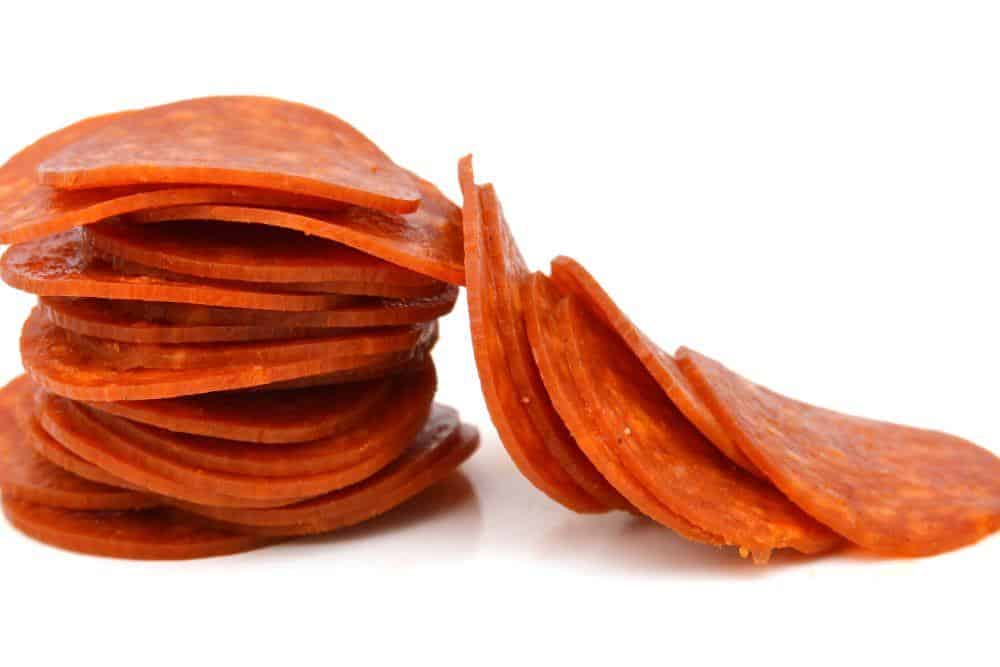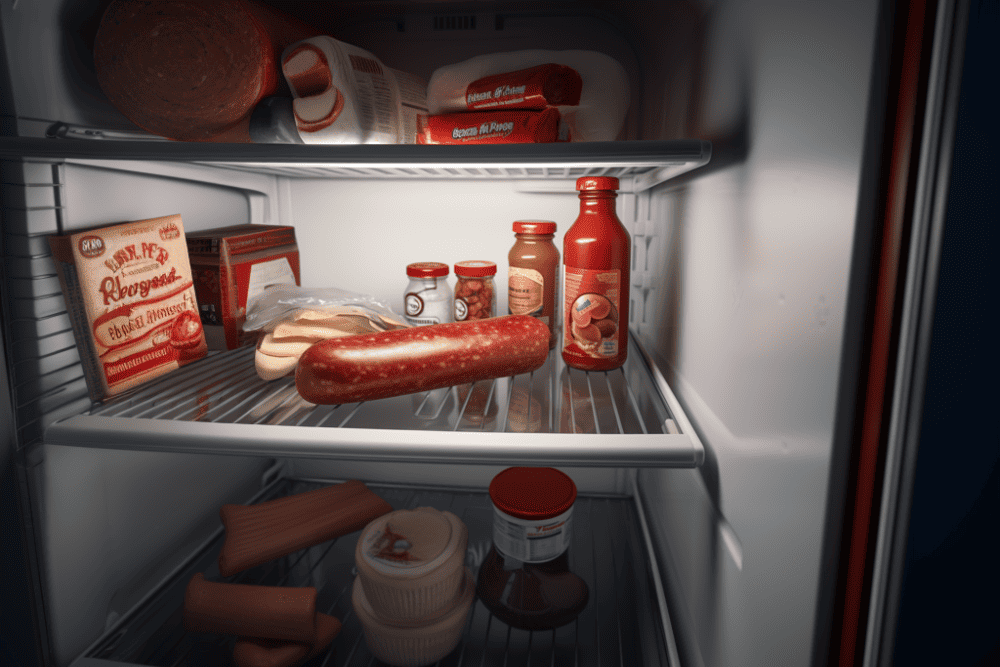Pepperoni is a beloved pizza topping and a tasty snack.
The little slices seem unassuming, but what happens if you accidentally leave them on the counter overnight? Or purchased too much? How should pepperoni be stored?
Keep reading for the answers to these pepperoni-related questions and more.
While people typically associate pepperoni with Italian cuisine, Americans invented and popularized the food.
However, the word pepperoni does have Italian roots. It comes from pepperoni, the Italian word for bell pepper.
While Italy does have spicy salamis that taste similar to pepperoni, the first recorded use of the food was not until 1919 in the U.S.

Believe it or Not, Pepperoni Originated in the United States - Not Italy
In the 1900s, Italian-American butchers created pepperoni to sell as a unique topping for their pizzerias. It began as a conglomerate of various spicy sausage recipes and evolved into the savory treat we know today.
In the U.S., chefs, and butchers make pepperoni out of ground pork. However, some chefs make pepperoni with a pork and beef mixture. Then, they add spices like paprika, nutmeg, black pepper, and cloves to enhance the flavor.
How to make cured pepperoni
Pepperoni is unique because it is a cured meat. Butchers and chefs use salt and sodium nitrate to cure pepperoni and other similar meats like salami, bacon, and prosciutto.
The purpose of curing is to prevent bacteria and microorganisms growth. Pepperoni achieves its distinct color through the curing process.
After curing the meat, chefs stuff it into tubed casings, like sausage. Then, the pepperoni ferments for a few days and is moved to a drying room before butchers package it for transport.
Some butchers slice the pepperoni while others leave it as a sausage-like tube.
Despite What Many May Think, Pepperoni Must Be Refrigerated
Since pepperoni is a cured meat, some people assume it is safe to eat no matter the circumstances. This statement is false.
Cured meat is not the same as cooked meat. Even so, can cooked pepperoni be left unrefrigerated?
The answer is no. No food that sits unrefrigerated for longer than two hours should be consumed - cooked, raw, or cured.
Why not? When food falls within a specific temperature range, there is an increased risk for bacteria growth and foodborne illness.
Continue reading for more information about correct pepperoni storage and food safety.
According to the USDA, the food “Danger Zone” indicates an increased risk of food-borne illness. When food falls between 140-40 degrees Fahrenheit, it becomes an excellent environment for harmful bacteria growth.
Food left out at room temperature (68 degrees Fahrenheit) reaches the lower end of this spectrum in just two hours.
Any food left out for longer than two hours, whether it is pepperoni or cooked bacon, is at increased risk for food-borne illness. The USDA does not recommend eating any pepperoni that has been unrefrigerated for longer than two hours.
If someone cooks pepperoni into a dish like pizza, some may think they can leave it out on the counter longer. However, this is not the case.
According to the USDA, all food left unrefrigerated for two hours is at increased risk for food-borne illness.
Make sure to refrigerate or freeze leftover food like pepperoni pizza and pepperoni rolls to ensure they are safe to consume.

Sorry to be the Bearer of Bad News - Even Pepperoni Cooked on a Pizza is a Potential Vector of Food Poisoning
If the USDA is so strict about the two-hour “danger zone,” how are grocery stores allowed to sell unrefrigerated pepperoni?
Many pepperoni companies manufacture special packaging that prolongs the pepperoni’s otherwise traditional shelf life. Companies design their meat packaging to reduce air as much as possible and add silica packets for excess moisture absorption.
This packaging is a great way to prevent food waste at grocery stores, but you should still refrigerate their purchased pepperoni at home.
Pepperoni left unrefrigerated overnight should not be consumed if you opened the package. Opening the seal breaks the two-hour rule for food safety.
However, if the pepperoni is in its original packaging and unopened, it should still be safe to eat. Remember to return it to the fridge to ensure the pepperoni remains unspoiled.
Since many people consume pepperoni via pizza, you shouldn't eat that pepperoni pizza that sat out on the kitchen counter overnight.
You greatly increase your chances of contracting a foodborne illness by eating dairy products (like cheese) or deli meat (including pepperoni) that has been left out.
Since so many brands make pepperoni using different recipes, there is not one general shelf life for the savory snack. This difference is why it is vital to always check the expiration date on the packaging label.
Expiration dates are the manufacturer’s best estimate of how long the pepperoni should remain fresh. These dates are not exact.
The pepperoni could stay fresh a few days longer or go bad a few days before. Refrigeration helps extend the pepperoni’s shelf life.
Always check the sell-by date on pepperoni because of the potential health risks associated with eating expired food.
Here are two signs to tell if pepperoni is no longer safe to consume.
Discard the pepperoni immediately if it appears discolored or slimy on the surface. The pepperoni has gone bad and is no longer safe to eat.
If you improperly wrap the pepperoni, the surface may change slightly in color. The pepperoni should still be safe if you refrigerated it, and it was not slimy. Cut off the exposed part and use up the rest.
Since pepperoni contains oil, a great way to decide if it is expired is to smell it. If it smells rancid or pungent, dispose of it immediately. Do not consume the pepperoni.
If the pepperoni seems fine and does not exhibit any of these signs, it is likely safe for consumption.

Sliced Pepperoni - Like All Pepperoni - Needs to be Refrigerated
Precut pepperoni slices need refrigeration after you open the package. Properly reseal the pepperoni bag, so it does not dry out.
Sometimes confused with pepperoni, summer sausage is a type of sausage that is typically made from pork, beef, or a combination of the two. The sausage is then seasoned with various spices, such as garlic, salt, and pepper.
Summer sausage is typically smoked and can be eaten either cooked or raw. It doesn't need to be refrigerated until after it has been opened.

Most Summer Sausage Can Last for a Long Time Without Being Refrigerated - Just be Sure to Check the Expiration Date
There are two different ways you properly store pepperoni: refrigeration or freezing.
Most people choose to refrigerate their leftover pepperoni if they plan to use it relatively soon. Refrigeration slows the pepperoni from drying out.

Sealed pepperoni can last for a long time in the refrigerator. You can put the leftovers in a resealable bag, squeezing out as much air as possible as you zip it back up.
If you have a pepperoni stick, cover the opened part in plastic wrap or aluminum foil to prevent drying. You could also pre-slice it into pieces and use a plastic bag.
If you have extra pepperoni you will not use for a while, freezing is also an option.
Companies cannot guarantee your pepperoni will maintain its original quality after you freeze it. However, if you do it properly, your pepperoni’s taste and texture stay the same.
Gather your pre-sliced pepperoni. If you have a pepperoni stick, slice it up into smaller chunks. This way, you can defrost as much or as little as you want.
Seal the pepperoni in a freezer bag, plastic wrap, or aluminum foil. Write the date you froze the pepperoni on its packaging.
To defrost, place the pepperoni in the fridge overnight for the best results.
According to the USDA, Pepperoni sticks, or the sausage, do not need refrigeration because it comes wrapped in a protective casing in addition to the curing preservatives. Storing it in a cool and dry area is ideal. Keeping it in the fridge may help prolong its shelf life.
After opening the pepperoni seal, you must refrigerate it within the USDA-approved two-hour time limit to decrease the risk of food poisoning. Remember to reseal the original bag or place the pepperoni in a resealable plastic container to prevent drying.
